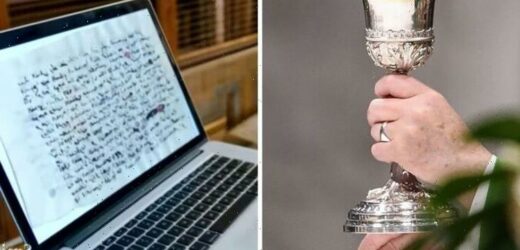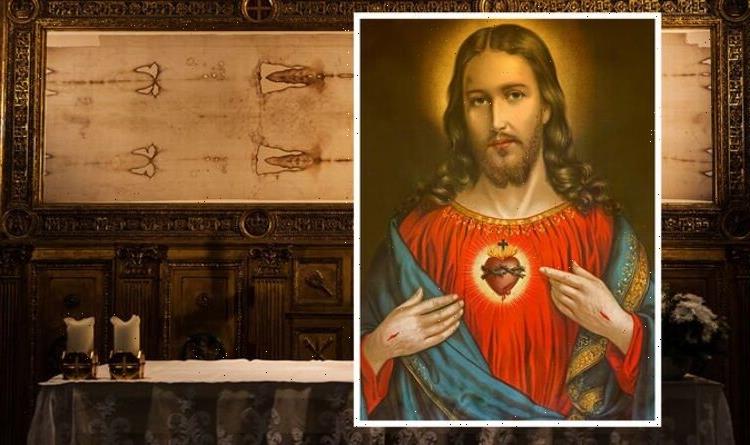Bible: Expert on discovery of story that was 'never included'
We use your sign-up to provide content in ways you’ve consented to and to improve our understanding of you. This may include adverts from us and 3rd parties based on our understanding. You can unsubscribe at any time. More info
The Easter weekend is the most important festival in the Christian calendar. Christians across the world gather in numbers to remember the last week of Jesus Christ, and the centrepoint of Christianity — that he was resurrected after his death. The week leading up to Easter Sunday is called Holy Week, and the Bible tells Christians that a number of things happened to Jesus in a whirlwind week.
Having arrived in Jerusalem on Palm Sunday (the week before Easter Sunday), Jesus spoke to many people about God on the Tuesday in what is now known as the Sermon on the Mount.
On the Thursday, he shared a meal with his 12 disciples — the Last Supper.
It was here that Jesus predicted the betrayal of one of his followers, which ultimately proved to be Judas Iscariot, and told them that he will die on a cross.
He was arrested after Judas led the Roman authorities to find him, and crucified on what is now called Good Friday.


Jesus is said to have then risen from the dead on Easter Sunday.
The Holy Grail is generally considered to be the cup from which Jesus drank at the Last Supper, and also the one used by Joseph of Arimathea to catch his blood as he hung from the cross.
Records show that a cup, believed to have been the Holy Grail itself, was kept in the Church of the Holy Sepulchre in Jerusalem.
This cup’s apparent disappearance was detailed in the 2016 Smithsonian Channel documentary ‘Secrets: The Holy Grail’.

In 909AD, the cup disappeared from history, only for Spanish historian Margarita Torres to stumble upon a medieval text detailing its disappearance.
Hidden in a library in Egypt, the document refers to an event some 150 years after the cup disappeared from Jerusalem.
Written in Arabic and translated into English, one particular line stands out: “The cup the Christians call the cup of the Messiah.”
The text is the first reference to the Holy Grail after 909AD, and tells the story of a Muslim entourage gifting the cup to Ferdinand the Great, the king of León from 1037 until 1065.
DON’T MISS:
Archaeologists stunned by ancient Babylonian device: ‘More advanced’ [INSIGHT]
Archaeologists stunned by theory: ‘Slaves saw Tower of Babel creation’ [QUOTES]
Pope Francis’ brutal assessment of EU’s ‘direction’ [REVEALED]

Yet Ferdinand did not rule in Jerusalem, or in fact anywhere remotely near Israel.
León was in fact an independent kingdom situated in the northwest region of the Iberian Peninsula.
Rising tensions between Christians and Muslims in 11th Century Jerusalem had resulted in the looting of churches, and sacred relics fell into Muslim possession.
Professor Joan Taylor, a historian who teaches in early Christianity and Second Temple Judaism, told the documentary: “The looting was phenomenal, but it went hand in hand with an enormous persecution of Christians and Palestines at the beginning of the 11th Century.”

At the same time, Spain, where Ferdinand ruled, was split in two.
Muslims ruled the south, and Christians the north.
The documentary’s narrator explained how León was the most powerful Christian kingdom, and Ferdinand wished to push south into Muslim kingdoms.
The document revealed that a Muslim ruler of Dénia, in the south of Spain, gave the cup of Christ to Ferdinand in a bid to prevent any possible invasion.
Evidence suggests Ferdinand believed this cup was the genuine Holy Grail, and it was only covered in gold upon its arrival in León in 1055.
The cup is now preserved in the Cathedral of Valencia, and still attracts the faithful on pilgrimage today.
Pope John Paul II celebrated mass with the chalice in November 1982, calling it a “witness to Christ’s passage on Earth”.
A number of other artefacts have come to be identified with the Holy Grail, including the Sacro Catino, kept in Genoa Cathedral.
The Genoa Chalice is a hexagonal dish of the Roman era made of green Egyptian glass, first claimed to be the Holy Grail in the 1290s.
Source: Read Full Article


